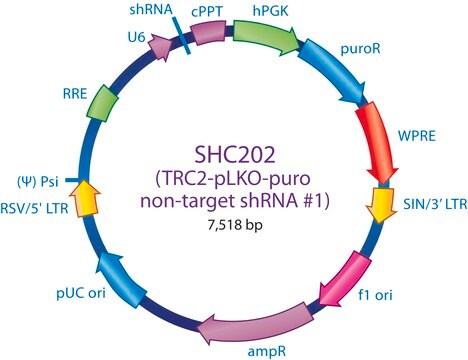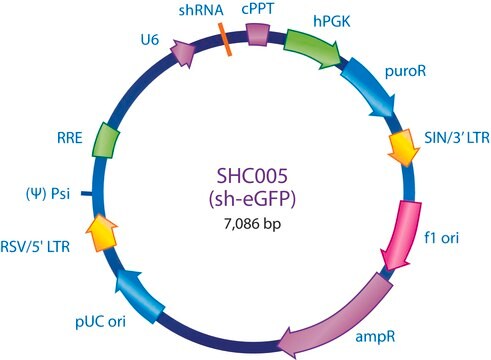SHC002V
MISSION® pLKO.1-puro Non-Mammalian shRNA Control Transduction Particles
Targets no known mammalian genes
Sinonimo/i:
MISSION®, MISSION® Control Transduction Particles
About This Item
Prodotti consigliati
Livello qualitativo
100
200
Nome Commerciale
MISSION®
Concentrazione
≥1x106 VP/ml (via p24 assay)
tecniche
capture ELISA: 106 TU/mL using p24
Condizioni di spedizione
dry ice
Temperatura di conservazione
−70°C
Cerchi prodotti simili? Visita Guida al confronto tra prodotti
Descrizione generale
Small interfering RNAs (siRNAs) expressed from short hairpin RNAs (shRNAs) are a powerful way to mediate gene specific RNA interference (RNAi) in mammalian cells. The MISSION product line is based on a viral vector-based RNAi library against annotated mouse and human genes. shRNAs that generate siRNAs intracellularly are expressed from amphotropic lentivirus viral particles, allowing screening in a wide range of mammalian cell lines. In these cell lines, MISSION shRNA clones permit rapid, cost efficient loss-of-function and genetic interaction screens.
The lentiviral transduction particles are produced from an shRNA lentiviral non-target control plasmid. It is useful as a negative control in experiments with the MISSION shRNA target sets.
Unlike murine-based MMLV or MSCV retroviral systems, lentiviral-based particles permit efficient infection and integration of the specific shRNA construct into differentiated and non-dividing cells, such as neurons and dendritic cells,1 overcoming low transfection and integration difficulties when using these cell lines. Self-inactivating replication incompetent viral particles are produced in packaging cells (HEK293T) by co-transfection with compatible packaging plasmids.2-3
In addition, the lentiviral transduction particles are pseudotyped with an envelope G glycoprotein from vesicular stomatitis virus (VSV-G), allowing transduction of a wide variety of mammalian cells.4 The lentiviral transduction particles are titered via a p24 antigen ELISA assay and pg/ml of p24 are then converted to transducing units per ml using a conversion factor. The conversion can be viewed at: www.tronolab.com.
To see more application data, protocols, vector maps visit sigma.com/shrna.
Applicazioni
Note legali
Raccomandato
Codice della classe di stoccaggio
12 - Non Combustible Liquids
Classe di pericolosità dell'acqua (WGK)
WGK 3
Punto d’infiammabilità (°F)
Not applicable
Punto d’infiammabilità (°C)
Not applicable
Dispositivi di protezione individuale
Eyeshields, Gloves, multi-purpose combination respirator cartridge (US)
Certificati d'analisi (COA)
Cerca il Certificati d'analisi (COA) digitando il numero di lotto/batch corrispondente. I numeri di lotto o di batch sono stampati sull'etichetta dei prodotti dopo la parola ‘Lotto’ o ‘Batch’.
Possiedi già questo prodotto?
I documenti relativi ai prodotti acquistati recentemente sono disponibili nell’Archivio dei documenti.
I clienti hanno visto anche
Articoli
Enhancing Lentiviral Transduction Efficiency
Protocolli
This detailed procedure allows you to transduce Mouse Embryonic Fibroblasts (MEF) using MISSION ExpressMag Super Magnetic Kit.
Il team dei nostri ricercatori vanta grande esperienza in tutte le aree della ricerca quali Life Science, scienza dei materiali, sintesi chimica, cromatografia, discipline analitiche, ecc..
Contatta l'Assistenza Tecnica.











